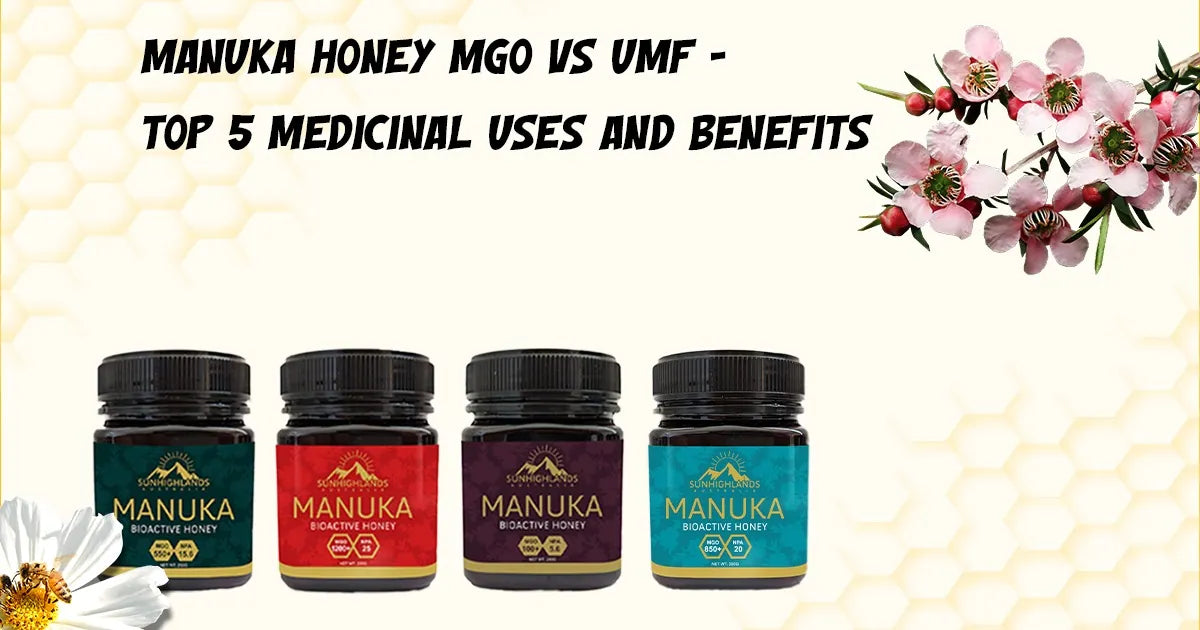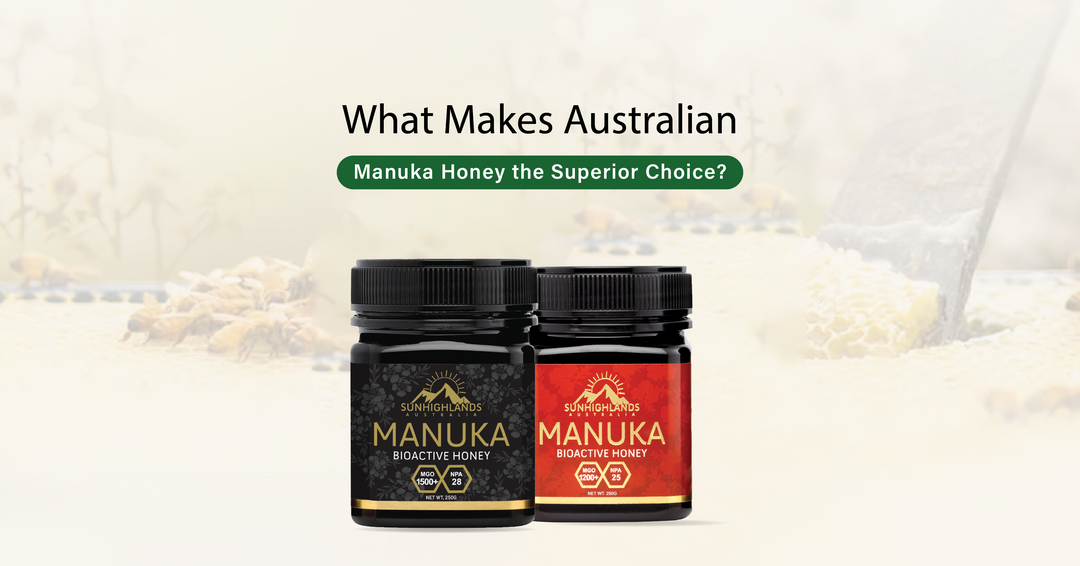Manuka Honey MGO vs UMF - Top 5 Medicinal Uses and Benefits

Have you ever heard of Manuka honey. It is a natural ingredieng that everyone in the medical sectors is talking about. It is a natural sweetener with added health benefits. Originating from the native areas of Australia, this special honey is known for its powerful antibacterial and therapeutic properties. Understanding its quality is very important. Two primary rating systems MGO (Methylglyoxal) and UMF (Unique Manuka Factor) helps to assess the honey’s potency and authenticity.
You might wonder, what’s the difference between MGO and UMF? And which one should you trust? Don’t worry; we’ve got you covered. By the time you finish reading this article, you can confidently choose the best Manuka honey for your needs.
In this article, we'll be exploring the differences between MGO and UMF Manuka honey, as well as looking at their medicinal uses, benefits, and side effects. Let's dive in!
What is Manuka Honey?
Manuka honey is a type of honey that is produced in New Zealand by bees that pollinate the manuka bush. The honey is unique because it contains high levels of a natural antiseptic called methylglyoxal (MGO). This chemical gives manuka honey its therapeutic properties.
Manuka honey has been used traditionally to treat wounds and infections. More recently, it has been shown to be effective against a wide range of bacteria, including drug-resistant strains such as MRSA. Manuka honey can also be used to treat skin conditions such as acne and eczema.
The main difference between Manuka honey and other types of honey is the concentration of MGO. Manuka honey with a higher concentration of MGO is more potent and has more medicinal benefits. However, all Manuka honey has some antibacterial activity.
When buying Best Manuka honey, look for products that are labeled with the MGO rating. The higher the MGO rating, the more potent the antibacterial activity.
Manuka Honey MGO vs UMF: Which is Better?
When it comes to the best manuka honey, there are two main types: MGO and UMF. Both have their own unique medicinal properties and benefits. But which is better?
MGO (methylglyoxal) is a naturally occurring compound found in manuka honey. It's responsible for many of the honey's antibacterial and antifungal properties. Studies have shown that MGO is effective against a wide range of bacteria, including Staphylococcus aureus (S. aureus), Escherichia coli (E. coli), and Pseudomonas aeruginosa (P. aeruginosa).
UMF (Unique Manuka Factor) is another type of manuka honey. Unlike MGO, UMF is not a single compound. Instead, it's a measure of the overall activity of the honey against bacteria and other microorganisms. The higher the UMF rating, the more potent the honey is thought to be.
So, which type of manuka honey is better? That depends on what you're looking for. so just write down, Best Manuka Honey near Me as
If you're looking for an all-natural alternative to antibiotics, then MGO-containing honey may be your best bet. If you're looking for something with a little more punch, then UMF-rated honey might be what you need.
Manuka Honey MGO Vs UMF: Medicinal Uses and Benefits
Raw Manuka honey is derived from the nectar of the Manuka bush (Leptospermum scoparium), which is native to New Zealand. This honey has been used for centuries by the Maori people of New Zealand for its medicinal properties.
Manuka honey has a unique composition that sets it apart from other types of honey. It contains high levels of hydrogen peroxide, as well as other compounds such as Methylglyoxal (MGO) and DHA (2-Deoxy-D-glucose). These compounds give Manuka honey its antibacterial and anti-inflammatory properties.
The most common way to use Manuka honey is topic, by applying it to the skin. This can be done by using a cotton swab or gauze pad to apply the honey directly to cuts, scrapes, or burns. The dressing can be left on for several hours or overnight.
Raw Manuka honey can also be taken orally to treat digestive issues such as stomach ulcers, Crohn's disease, and irritable bowel syndrome. The recommended dosage is 1-2 tablespoons per day. When taking Manuka honey orally, it's important to start with a small amount and gradually increase the dosage over time to avoid any adverse effects.
There are a few potential side effects associated with Manuka honey, such as allergic reactions in some people. It's always best to do a patch test on a small area of skin before using it
How to Recognize Quality Manuka Honey
There are a few key indicators of quality Manuka honey. First, look for honey that is sourced from New Zealand, as this is where the Manuka tree grows. The honey should also have a label that indicates the minimum amount of Methylglyoxal (MGO) present. MGO is a naturally-occurring compound in Manuka honey that gives it its unique medicinal properties. A good quality Manuka honey will also have a dark color and a thick, viscous consistency.
When purchasing Best Manuka honey, be sure to buy from a reputable source. There are many fake or low-quality products on the market, so it's important to do your research before buying. Look for reviews from other customers or experts in the field to help you choose a quality product.
If you're looking for a specific medicinal use for Manuka honey, be sure to choose a product with the appropriate label. For example, if you're looking for an antibacterial effect, choose a product with a UMF (Unique Manuka Factor) rating of 10 or higher.
If you're looking for an anti-inflammatory effect, choose a product with an MGO rating of 250 or higher. Always consult with your healthcare provider before using any medicinal product, including Manuka Honey MGO or UMF
The Comparison of Ratings
The comparison of Manuka honey MGO vs UMF is for the better understanding of the consumer. It helps to determine the quality and benefits of Manuka honey. Both rating systems measure key aspects of the honey’s antibacterial properties, but they evaluate these attributes differently.
A compound found in Manuka honey that is responsible for its antibacterial strength is Methylglyoxal commonly reffered to as MGO. The MGO rating measures the concentration of this compound. Higher MGO levels mean stronger antibacterial activity.
A more comprehensive rating system is UMF (Unique Manuka Factor). This rating helps measure other important compounds like DHA (Dihydroxyacetone) and leptosperin along with MGO. In order to better understand MGO vs UMF comparison, think of MGO as a single-focused spotlight, while UMF is a multi-faceted diamond reflecting the honey’s overall medicinal value.
Understanding MGO and UMF Ratings
What is MGO in Manuka Honey?
MGO, or methylglyoxal, is the primary compound resposible for Manuka honey's antibacterial properties. MGO basically depicts potency of the honey. For example MGO 100+ has moderate anti bacertial ability, while MGO 400+ has a stronger punch to fight bacteria.. The MGO rating reflects the concentration of methylglyoxal in milligrams per kilogram of honey. It’s a key factor in wound healing, fighting infections, and supporting gut health.
What is UMF in Manuka Honey?
UMF, or Unique Manuka Factor, is a trademarked rating system that goes beyond jus MGO. It assesses Manuka honey's overall quality by measuring MGO, DHA, and Leptosperin. UMF ratings generally range from 5+ to 20+, with higher numbers meaning greater potency.
Manuka MGO vs UMF
The primary concern of MGO rating is the antibacterial power of the honey where as UMF rating covers a vast area that has a composition of balanced compounds and includes all medical facets. Each rating systems work in their own way have their own effectiveness..
Better Choice MGO or UMF?
UMF or MGO, which one is better? The answer to this question depends purely on what you need the honey for. If you’re looking for antibacterial properties, go for a high rating of MGO. If you want a well-rounded quality Manuka honey ,UMF is the one for you.
Specific Ratings and Benefits Comparison
Benefits of High UMF vs. High MGO Manuka Honey
High UMF-rated honey offers a comprehensive range of benefits, from antibacterial effects to antioxidant properties. In contrast, high MGO honey is ideal for specific uses, such as topical wound application.
Best Uses of UMF-Rated Manuka Honey
UMF-rated honey is excellent for daily consumption to boost immunity, improve digestion, and promote skin health.
Best Uses of MGO-Rated Manuka Honey
MGO-rated honey works best for medical applications, including treating wounds, ulcers, and bacterial infections.
High UMF vs. High MGO: Which Is Better for Health Benefits?
For overall health benefits, high UMF honey is the better choice due to its well-rounded profile. However, for targeted antibacterial treatment, high MGO honey is more effective.
Conclusion
Raw Manuka honey is a unique and powerful natural remedy that has been used for centuries to provide relief from various ailments. The two main grading systems, MGO and UMF, allow users to make sure they are getting the real deal when purchasing Manuka honey.
Understanding the differences between Manuka honey UMF vs MGO can help you choose the right honey for your needs. Whether you prioritize antibacterial strength with MGO or prefer the comprehensive assurance of UMF, both ratings offer unique benefits. Evaluate your health goals and select accordingly to enjoy the incredible properties of Manuka honey.





